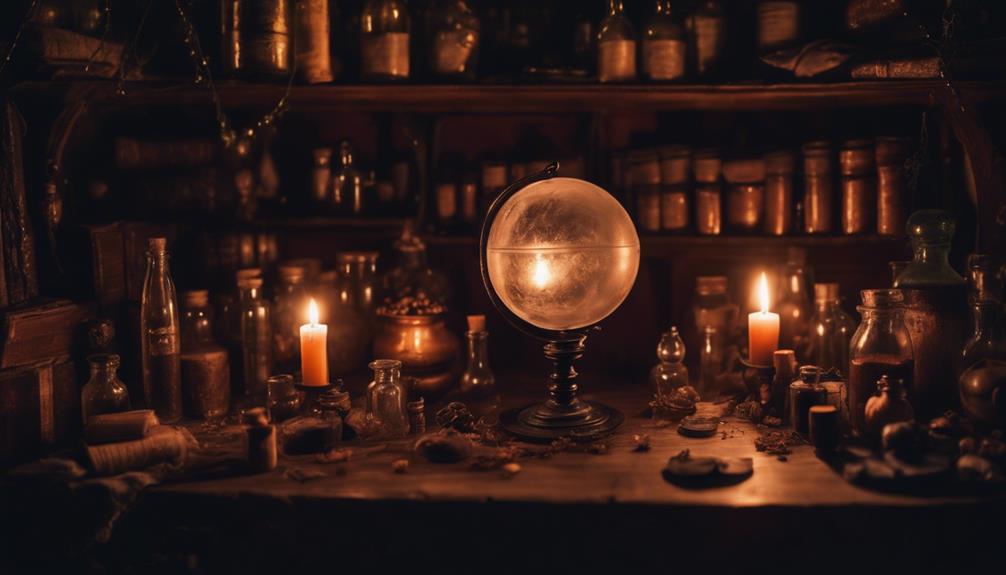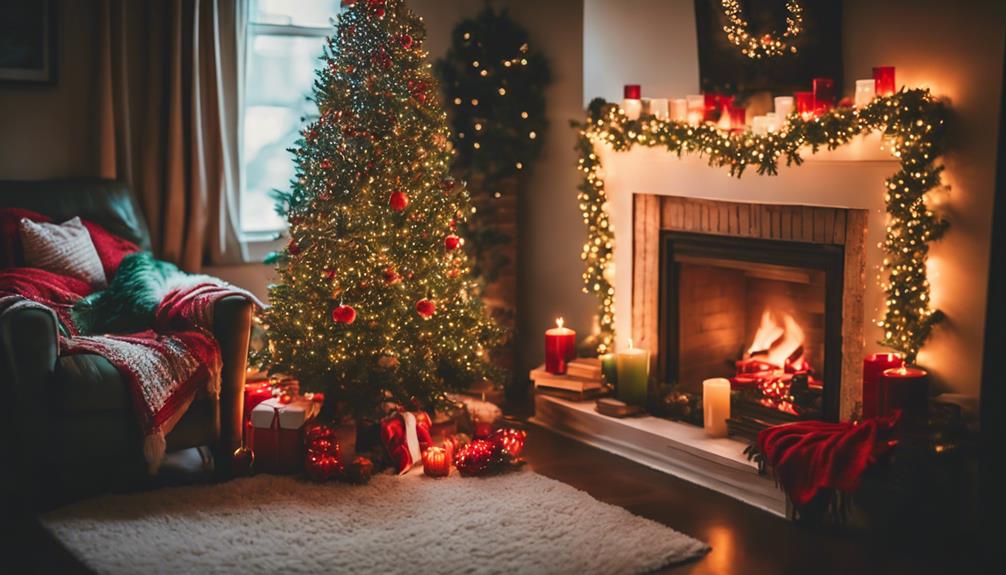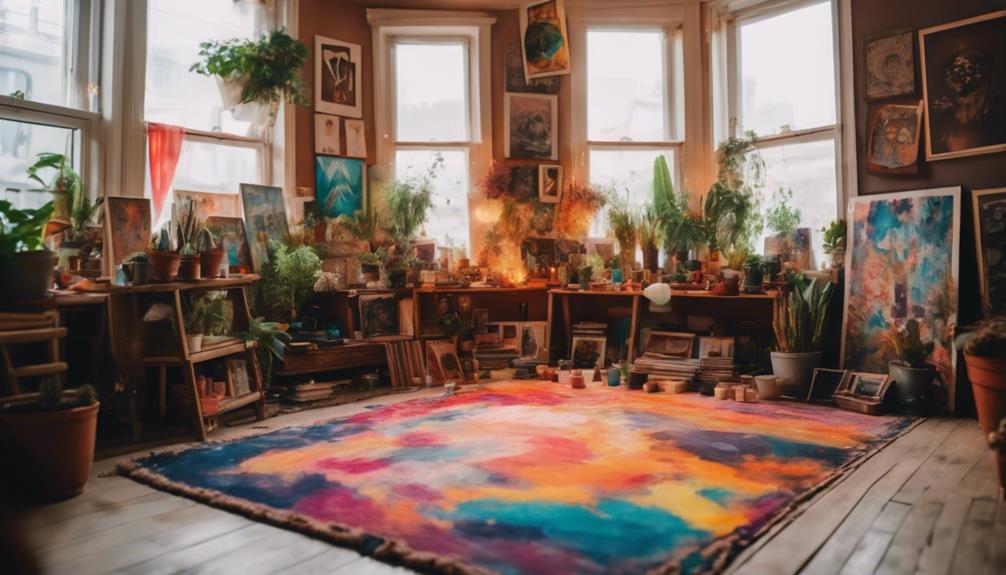To use batik for a trendy yet timeless home design, start by incorporating vibrant batik textiles in soft furnishings like cushions and curtains. Choose neutral color palettes to let batik's intricate patterns shine. Mix various batik patterns for an eclectic look, while maintaining balance with classic furniture. Batik tableware can elevate dining experiences, adding cultural flair. Consider using framed batik art as striking focal points on walls. Quality materials and personal touches will harmonize with the batik elements, creating a cozy atmosphere. There's plenty more to explore about implementing batik's unique charm in your space.
Key Takeaways
- Incorporate batik textiles like curtains, cushions, and table runners to add vibrant patterns and cultural flair to your home decor.
- Choose a neutral color palette to allow the rich colors of batik fabrics to stand out without overwhelming the space.
- Layer batik pieces with classic furniture for a harmonious blend of contemporary and traditional styles that reflects personal taste.
- Use high-quality, locally sourced materials to enhance the durability and aesthetic appeal of batik designs in your home.
- Create focal points with batik art pieces or accent furniture, ensuring a cohesive look while maintaining elegance and sophistication.
Overview of Batik

Batik is a fascinating textile art form that hails from Indonesia, known for its unique wax-resist dyeing technique. This ancient craft, dating back over 2,000 years, showcases intricate designs that reflect cultural identity and heritage.
Recognized by UNESCO as a Masterpiece of the Oral and Intangible Heritage of Humanity, batik holds a special place in the hearts of many. It shares similarities with other traditional Indonesian art forms, such as Indonesian Decor Masks, which also embody rich cultural narratives and craftsmanship.
You'll find two primary methods used in batik: hand-drawn (batik tulis) and stamped (batik cap). Each technique allows for a variety of stunning designs, often rich with symbolism and meaning tied to cultural traditions.
Batik patterns aren't just beautiful; they frequently play a role in ceremonies and traditional events, making them both functional and expressive.
In contemporary home decor, batik is making a splash. You can transform your living space by incorporating batik cushions, table settings, and wall art.
These vibrant textiles bring a touch of cultural richness and personality to any room, enhancing the overall aesthetic. By integrating batik into your home decor, you celebrate its cultural significance while adding a trendy yet timeless flair to your surroundings.
Essential Materials for Batik

When diving into batik, you'll often find that selecting the right materials is essential for achieving stunning results. Start with a high-quality fabric base, like white cotton or silk, which guarantees vibrant color absorption and durability. Incorporating traditional Indonesian elements, such as a Face Indonesian Decor Mask, can further enhance your creative space.
Next, you'll want to choose your dyes wisely; Dylon cold water powder dyes are perfect for batik projects since they offer strong, durable colors that are easy to mix.
For the hot wax application, a 60/40 mixture of beeswax and paraffin wax is recommended. This blend provides flexibility, reducing the chances of cracking during the dyeing process. Essential tools include brushes or a canting tool, which allows for precise wax application, and a wooden frame to keep your fabric taut while you work.
Don't forget about safety gear! Confirm you're in a well-ventilated area for heating the wax, and keep rags handy for any spills.
These materials and precautions will set the foundation for your batik project, making it easier to create beautiful designs that can elevate your home decor. Get ready to release your creativity with these essential materials!
Step-by-Step Batik Method

To get started with the batik process, you'll need to gather essential materials and tools, like high-quality fabric and a canting tool.
Once you've got everything ready, you can focus on the dyeing and waxing techniques that will bring your design to life.
Let's walk through the steps to create stunning batik pieces for your home.
Essential Materials and Tools
Creating stunning batik designs starts with gathering essential materials and tools that will set the foundation for your artistic process. First, select high-quality white cotton or silk fabric. Make sure it's washed, dried, and ironed before starting. Next, prepare a 60/40 mixture of beeswax and paraffin wax for applying on the fabric; this blend is pliable and less prone to cracking during dyeing.
You'll need brushes or a canting tool to apply hot wax in intricate patterns, covering areas you don't want to dye. Once the wax cools, mix your Dylon cold water powder dyes according to the instructions and submerge the fabric, adjusting the soaking time for your desired color depth.
Finally, remove the wax by placing newspaper and brown paper over the fabric and ironing it to melt the wax off, revealing your unique batik design.
| Material/Tool | Purpose |
|---|---|
| Cotton/Silk Fabric | Base for batik designs |
| Beeswax/Paraffin Wax | Wax application for dye resistance |
| Brushes/Canting Tool | Detailed wax application |
| Dylon Cold Dyes | Color for your batik creations |
| Iron & Paper | Wax removal and design finishing |
Dyeing and Waxing Techniques
Start by preparing your fabric to guarantee the best results in your batik project. Wash it thoroughly to remove any chemicals, then dry and iron it to create a smooth surface for your dyeing and waxing techniques. Incorporating vibrant colors and intricate patterns can enhance your batik design, reflecting the rich cultural heritage of Indonesia through Indonesian Decorative Pillows.
Next, sketch your desired design on the fabric using a soft pencil, making sure the lines are dark enough to see once you apply the wax.
Melt a 60/40 mixture of beeswax and paraffin at a controlled temperature. With a canting tool or brush, carefully apply the wax to the areas of the fabric you want to keep undyed. This step is essential, as the wax acts as a barrier against the dye.
Now, submerge the waxed fabric in a dye bath. The soak time will determine the depth of color, so adjust accordingly. If you want to use multiple colors, repeat the waxing and dyeing process as needed.
Creative Wax Removal Techniques

Removing wax from batik fabric can be a delicate process that requires both care and creativity. Start by placing your fabric between two layers of absorbent paper, like newspaper or brown paper. Set your iron to low to medium heat, and gently press the fabric. The warmth will melt the wax, allowing it to be absorbed into the paper.
Watch carefully to avoid overheating, which can damage your beautiful design. Incorporating intricate designs inspired by local myths can further enhance the cultural significance of your batik pieces.
For intricate designs or stubborn residues, you might consider using a soft brush or a cotton swab dipped in a solvent like rubbing alcohol. This can help lift any remaining wax without harming the fabric.
After the initial removal, let the fabric cool completely; this makes it easier to spot any leftover wax. Once you've confirmed all the wax is gone, wash the fabric in cold water. This final step helps eliminate any remaining dye and sets the colors for your wall art projects.
Safety Precautions and Tips

When working with batik, your safety should always come first. Handling hot wax and dyes can be risky, but by following some essential precautions, you can guarantee a safer experience.
It's important to recognize that traditional techniques, such as those used in Rumah Adat, often involve similar care when working with materials. Start by wearing proper safety gear, like gloves and goggles, to protect yourself from burns and skin contact with the hot materials.
Make sure to work in a well-ventilated area when heating wax to avoid inhaling any fumes. It's also crucial to keep your workspace clear of flammable materials.
Here are a few more tips to keep in mind:
- Store wax and dyes safely, away from children, to minimize health risks.
- Use rags to quickly clean up any spills, as hot wax can create slip hazards if left unattended.
- Always maintain temperature control when working with hot wax to prevent burns and guarantee a smooth application.
Space Planning With Batik

Batik can transform your space planning by adding vibrant patterns and textures that enhance your home's aesthetic. By incorporating batik fabrics, you can create visually striking focal points that elevate the design without overwhelming it.
Start with batik-patterned curtains or drapes; they'll infuse your space with color while allowing natural light to flow in, making rooms feel larger and more inviting. The seamless integration of indoor and outdoor spaces, a hallmark of Balinese design, can be beautifully complemented with batik elements, creating a harmonious environment.
Next, consider batik cushion covers. Strategically placing them on your furniture introduces color and texture, contributing to a cozy atmosphere that draws guests in.
In dining areas, batik table runners or placemats can't only enhance the dining experience but also add a cultural flair to your gatherings, making every meal feel special.
To guarantee a cohesive look, choose batik patterns that complement your existing color scheme and decor style. This careful selection ensures seamless integration within your room layout, helping you maintain a harmonious design.
With these strategies, you'll be able to effectively use batik to create beautiful focal points while enhancing the overall aesthetic of your home.
Timeless Design Principles

When you think about timeless design principles, focus on choices that exude enduring style.
Integrating personal touches, like unique batik patterns, can add character while keeping your space relevant.
Additionally, incorporating natural materials and local crafts can enhance the aesthetic appeal of your home decor, reflecting a connection with nature and culture, as seen in traditional Indonesian style home decor.
Balancing these elements creates a cohesive and inviting environment you'll love for years to come.
Enduring Style Choices
Incorporating timeless design principles into your home creates a space that feels both elegant and welcoming. By integrating classic elements, you can beautifully complement batik patterns that showcase cultural heritage and artistry. Using batik patterns in decor allows you to introduce intricate designs and vibrant colors that reflect a deep sense of tradition. These patterns can be seamlessly blended with neutral tones and natural materials, offering a harmonious balance between simplicity and artistry. The result is a space that feels both culturally rich and visually captivating.
For instance, utilizing high-quality materials sourced locally can enhance the overall aesthetic, similar to the approach of luxury tropical design aesthetics offered by Mahallati Interiors.
Here are a few enduring style choices to contemplate:
- Neutral Color Palette: A neutral foundation allows the vibrant colors and intricate designs of batik to shine without overwhelming your space.
- Symmetry and Focal Points: Use batik textiles, like cushions or wall art, to create visual interest and balance in your decor.
- Comfort and Beauty: Select batik pieces that not only enhance aesthetics but also add comfort, guaranteeing your home feels cozy and inviting.
When you thoughtfully incorporate batik into your design, you resonate with timeless principles while personalizing your space.
These choices guarantee that every detail reflects both functionality and elegance, making batik an ideal addition for enhancing your home's ambiance.
Embrace these enduring style choices, and you'll create a harmonious environment that stands the test of time.
Personal Touch Integration
Integrating personal touches into your home design not only enhances its aesthetic but also creates a space that tells your unique story. One way to achieve this is by incorporating batik patterns, which reflect your identity through their individual craftsmanship and variations in design.
Indonesian wedding decor ideas can inspire your choices, as batik's vibrant colors and intricate designs are often celebrated in traditional celebrations. By selecting batik colors and styles that resonate with your taste, you create a harmonious environment that embodies your personal touch while maintaining timeless elegance.
Consider using batik fabric for throw pillows or wall art. These elements can connect you to your culture and add a meaningful layer to your decor.
Layering batik with classic furniture allows for a sophisticated blend of contemporary and traditional styles, ensuring that your space remains stylish regardless of changing trends.
Classic Style and Decoration

Classic style decoration creates an inviting foundation for your home, where quality materials and neutral color schemes set the stage. This timeless aesthetic allows batik patterns to shine as vibrant accents without overwhelming the overall design.
By incorporating batik into classic interiors, you can enhance visual appeal and maintain elegance, much like the modern tropical aesthetics in Bali that emphasize natural materials and a connection to the outdoors.
Consider these tips for integrating batik into your classic decor:
- Use batik art pieces as striking centerpieces to draw the eye and create focal points.
- Layer batik textiles in soft furnishings like cushions and drapes to introduce texture and color while keeping a sophisticated atmosphere.
- Introduce accent colors from batik patterns thoughtfully to guarantee a cohesive and balanced look throughout your space.
Clean lines in both furniture and batik designs help you avoid a dated aesthetic, allowing seamless integration of traditional craftsmanship with contemporary styling.
Selecting Furniture and Materials

When you're selecting furniture for your batik-themed space, focus on quality materials that enhance the vibrant patterns of batik fabric.
Look for pieces that not only integrate batik elements but also feature clean, modern lines to keep the design fresh and appealing.
Choosing Quality Materials
Choosing quality materials is essential for achieving a harmonious home design that showcases the beauty of batik. When you prioritize high-quality fabrics and natural materials, you create a space that feels both stylish and comfortable.
Here are some tips to guide you:
- Opt for durable batik fabric for upholstery on your dining chairs and sofas. This guarantees vibrant colors and longevity, making your furniture a lasting investment.
- Select Australian-made timber tables that complement your batik patterns. This choice not only enhances your overall aesthetic but also adds a timeless appeal to your dining area.
- Incorporate upholstered chairs in quality fabrics featuring batik designs. These chairs will provide comfort while adding a unique decorative touch to your dining space.
Integrating Batik Elements
Integrating batik elements into your home design can transform a space into a vibrant and culturally rich environment. When selecting furniture, choose high-quality timber pieces that harmonize with the rich textures and colors of batik fabric. Upholstered chairs featuring batik patterns not only provide comfort but also showcase this traditional art form, adding a unique flair to your interior.
Consider the following options for effectively integrating batik elements:
| Furniture/Material | Purpose |
|---|---|
| Upholstered Chairs | Showcase batik patterns and comfort |
| Accent Pillows/Cushions | Easy decor updates with intricate designs |
| Batik Tableware | Create an elegant dining experience |
Accent pillows or cushion covers made from batik fabric are a simple way to refresh your decor while maintaining a timeless style. You can also elevate your dining experience with batik tableware, like placemats or table runners, paired with neutral dinnerware. Finally, enhance your living space by integrating batik fabric into window treatments, adding privacy and character that complements various decor styles.
Personalizing With Batik Elements

Bringing batik elements into your home design can transform your space with vibrant patterns and a rich cultural narrative. You can easily personalize your home by incorporating batik fabric into various DIY projects. Here are a few ideas to get you started:
- Cushion Covers: Use colorful batik fabric to create unique cushion covers that instantly brighten up your living area.
- Wall Hangings: Frame stunning batik pieces to create a striking focal point, showcasing the intricate designs and history of this art form.
- Table Settings: Enhance your dining experience with batik tableware and linens, making every meal feel special.
Don't hesitate to mix and match different batik patterns across your home elements, like curtains, throws, and upholstered furniture, for an eclectic yet cohesive look.
If you're feeling adventurous, consider engaging in local workshops or online classes to learn batik techniques. This allows you to craft custom pieces that reflect your personal style and artistic vision.
Frequently Asked Questions
How to Make Your House Look Timeless?
To make your house look timeless, choose a neutral color palette, invest in classic furniture with clean lines, emphasize symmetry, and incorporate personal touches. Avoid fleeting trends for a cohesive and enduring design aesthetic.
What Is the Difference Between Trendy and Timeless Home Design?
Did you know that 75% of homeowners prefer timeless designs? Trendy styles flash by, while timeless aesthetics blend quality and personal touches, ensuring your space remains appealing and practical for years, resisting the cycle of fleeting trends.
How Do You Make Timeless Designs?
To create timeless designs, focus on quality materials and craftsmanship. Incorporate classic elements, layer textures, and add personal touches. Avoid chasing trends, allowing your space to remain sophisticated and enduring through changing styles.
What Design Material Used Modern Batik?
Imagine vibrant fabrics draping your space, each piece alive with color. You'll find modern batik often uses cotton, silk, and rayon, creating stunning designs that elevate your home's aesthetic while respecting sustainable practices.
Conclusion
Using batik in your home design isn't just a trend; it's a timeless approach that weaves culture and creativity into your space. By incorporating this unique textile, you're not only adding vibrant patterns but also telling a story. Imagine how the intricate designs can evoke warmth and personality, transforming your home into a welcoming sanctuary. So, embrace the art of batik and let your personal style shine through, proving that tradition can perfectly coexist with modern aesthetics.









